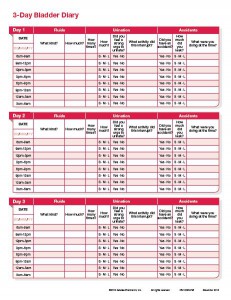Evaluating Overactive Bladder Symptoms with a Bladder Diary
A bladder diary, also known as a voiding diary, is indispensable to urologists for the evaluation of symptoms and causes associated with overactive bladder. A bladder diary is kept by the patient over the course of three to seven days, and allows the healthcare provider to evaluate the patient’s bladder function based on fluid intake and output. The diary captures how much fluid the patient is taking in during the day, how frequently the patient is urinating both day and night, if there are leaking accidents, and how much urine was lost.
Completing a bladder diary is a simple process. The patient begins their diary when they wake up each morning, and continues making notes throughout the day. At Urology Austin, the diary consists of three sections: fluids, urination, and accidents.
Bladder diary – fluids
Each time a fluid is consumed, the patient will indicate this by date, time, what type of fluid was consumed, and how much of each fluid. Fortunately, most containers list the serving size and the ounces in each serving.
Bladder diary – urination
Equally important is capturing information on urination during the day and night. Oftentimes, the healthcare provider will recommend the use of a special collection container which can help to measure urine amounts. This section of the diary will capture the time of urination, how much urine was released (small, medium, or large amount), and if the patient felt a strong urge prior to urination.
Bladder diary – accidents
It’s also valuable for the healthcare provider to know if the patient had any wetting accidents while keeping their bladder diary. The diary will capture whether the patient had a wetting accident, when it happened, how much urine was lost (small, medium, or large amount), and what the patient was doing when leakage occurred. Unfortunately, an overactive bladder can disrupt many daily and social activities that are important to the patient. In addition, overactive bladder symptoms may keep patients from participating in activities that they enjoy.
By recording wetting accidents, the provider can determine if there is a pattern or trigger associated with the leakage. For instance, was the leakage due to a specific activity such as exercise, lifting, sneezing, coughing, or laughing. These types of triggers may point to stress incontinence.
If you are experiencing overactive bladder, urinary frequency, urgency, or wetting accidents, contact Urology Austin to schedule an appointment.
Related link

